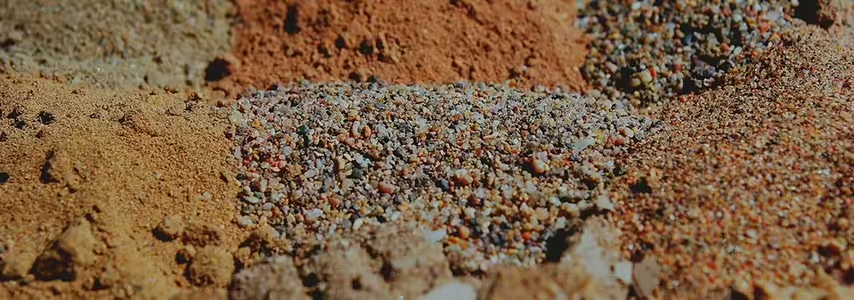Different types of soil will affect your building’s foundation in different ways. Determining the type of soil a building will be built on affects the project’s construction and future repairs.
Here are several of the most common types of soil foundation used in construction. We explore which type is generally the best type of soil to build on.
Common Types of Soil Used in Construction

Clay
Clay is not an ideal soil for buildings due to its tendency to shift around as it dries or moistens. This can cause cracks or fissures in the building and result in uneven floors. Clay soil foundation depths are generally deeper to increase stability.
When it comes to clay soil, the best house foundation would be between a drilled pier foundation or a slab-on-grade foundation. Drilled pier foundations will anchor deeper into the clay for more structural stability while slab-on-grade foundations combat clay soil’s tendency to shrink and expand.

Sand and Gravel
Sand and gravel have large particles which allow this soil to drain water quickly (which is good for buildings). Retaining less water means less risk for the building to shift around and form structural and non-structural cracks. Compacted sand and gravel offer even more stability and are a great option to build a foundation on.
Over time, sand can be washed away. In these cases, a helical pier (also referred to as helical anchors, screw piles, or screw anchors) is a suitable foundation technique for sandy soil.

Rock/Bedrock
There are many types of rock (sandstone, limestone, etc.) and they are all excellent options due to their high bearing capacity (making this type of foundation ideal for larger buildings). Bedrock is a layer of rock underneath a surface layer of soil.
Unlike with clay, which can expand and shift, bedrock is more stable and resistant towards water damage. Your building is, therefore, less likely to crack as it shifts or settles. The most important thing about building foundation on rock is to ensure the surface is level before construction.

Loam
Loam is the best soil type for construction due to its ideal combination of silt, sand, and clay. It combines the best of all their qualities into the ideal balance for supporting a foundation. Loam generally does not shift, expand, or shrink drastically and handles the presence of water very well.
The one potential drawback of building on loam is the possibility of undecomposed material, which can and should be filtered prior to construction.

Peat
Peat is often found in areas such as bogs and other wetlands and consists of decaying vegetation and/or organic matter. It can hold a large amount of water and is considered a very poor soil type for a foundation due to how much it can shift around and its low bearing capacity. You can build on peat soil, but the building would be at great risk of cracks or other types of damage.

Silt
Like peat, silt is another poor soil option for building a foundation due to its prolonged ability to retain water. This quality causes silt to shift and expand, which does not provide the building any support and puts it under repeated, long-term stress. This can cause structural damage or failure. If possible, construction should be pursued with a more suitable type of soil.]
Effects of Not Considering Soil Type Before Construction
Failing to select the best type of soil for your project can result in immediate or future foundation issues. Make sure you understand the different characteristics of each soil type and prevent possible damage.
There are several factors beyond water retention that builders should be aware of, so it’s crucial that you get an expert opinion.
Contact Leveled Concrete for Expert Foundation Repair in Houston
Proper soil knowledge and foundation experience are vital for a building’s structural integrity and safety. If you’re concerned that the type of soil you’ve built on is leading to foundation problems, Leveled Concrete can help.
Contact our dedicated team of Houston foundation repair experts today for a free estimate.


